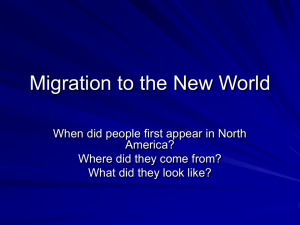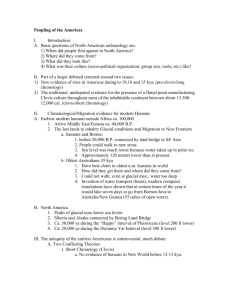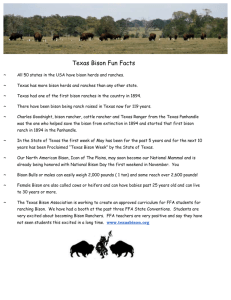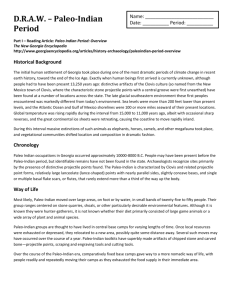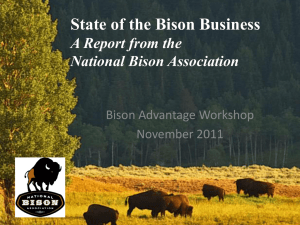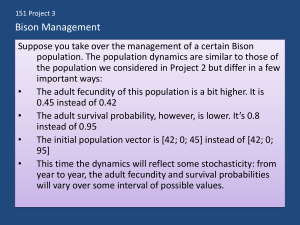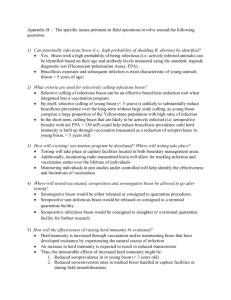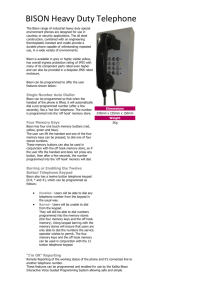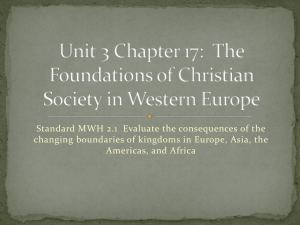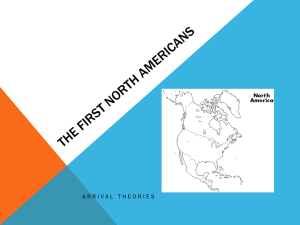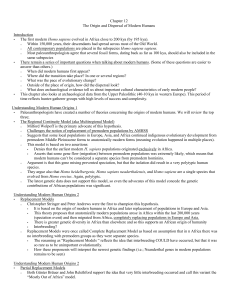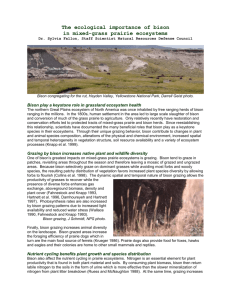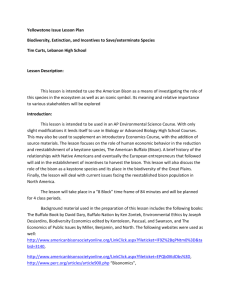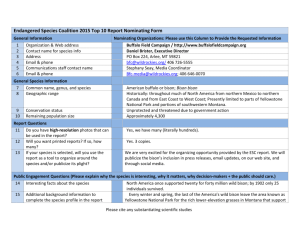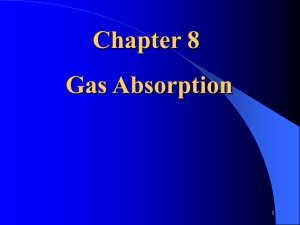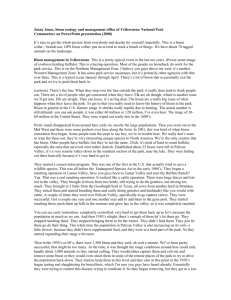Pre-Columbian Archaeology of North America
advertisement
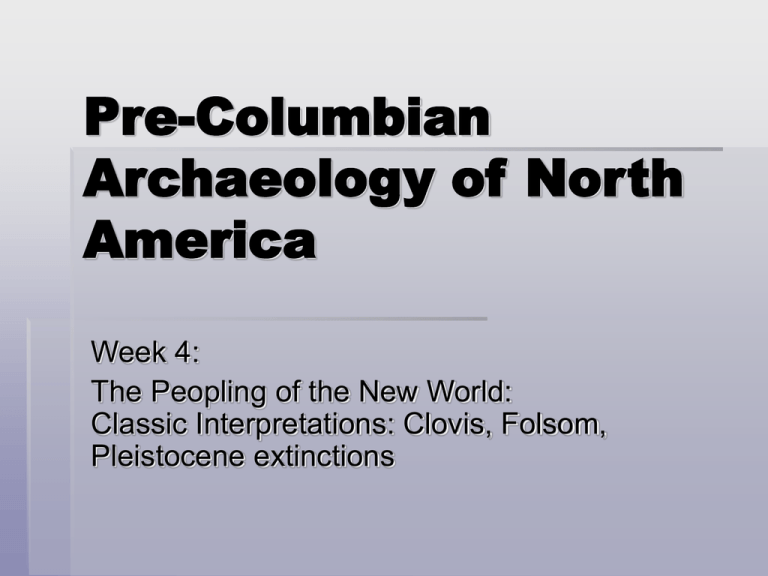
Pre-Columbian Archaeology of North America Week 4: The Peopling of the New World: Classic Interpretations: Clovis, Folsom, Pleistocene extinctions Pre-1930s Explanations No evidence for pre-Holocene occupation Hrdlička Folsom Clovis Environment of Pleistocene America Two major glacier groupings: Greenland Glacier Cordillerian Glacier Extended quite far south (c. 40° N) Great Lakes completely ice-covered Only exist in present form for less than 8,000 years Global ice coverage reconstruction: c. 18,000 years ago Global ice coverage reconstruction: c. 12,000 years ago Flora Predominance of spruce [smrk] Poplar [topol] also widespread Steppe = short-grass prairie Fauna Megafauna During the Pleistocene, large fauna are found throughout the world, with species being much larger than their modern descendants Giant kangaroos in Australia Wooly rhinoceros in Europe Major herbivore species Mammoths – 3 main species Columbian mammoth (Mammuthus columbi) Jefferson’s mammoth (Mammuthus jeffersoni) Wooly mammoth (Mammuthus primigenius) American Mastodon (Mammut americanum) Bison Horse Ground sloths Mammoths Jefferson’s and Columbian mammoths are descendants of M. meridionialis Arrived from Asia c. 1.8 mya Wooly mammoths arrived less than 500 kya Adults 3-4 m at shoulder 5500-7300 kg Flat, plate-like teeth Grazers Long, curving tusks Longest measures 4.9 m Longest of any member of the elephant family Pygmy mammoths (Mammuthus exilis) Found on Channel Islands off southern coast of California Likely evolved from Columbian mammoth c. 20 kya 1.2-2.4 m at shoulder Columbian (left) and Jefferson’s (right) Mammoths American Mastodon Mammut americanum Existed in N. America from 3.75 mya to 10 kya Adults: 2-3 m at shoulder 3500-5400 kg Cone-like teeth Browsers Bison Bison antiquus 15-20% larger than the modern American bison/buffalo (Bison bison) 220 cm at top of hump, 1300 kg Considered ancestral Similar behavior patter/range as modern bison Horse All species of horse evolved in the Americas and spread across the Bering land bridge to the rest of the world Western Horse (Equus occidentalis) Primary Pleistocene species in N. America Superficial resemblance to modern Zebras Ground Sloths Four species Found throughout North and South America Much larger than modern relatives (2 and 3 toed sloths) 2.5-3 to 6 m in length Up to 4000 kg Browser-used hook-like claws to pull down branches, etc. Pictured is Harlan’s Ground Sloth (Paramylodon harlani) Major carnivore species Saber-toothed cat American lion Dire wolf Short-faced bear Saber-toothed Cat Smilodon fatalis Mistakenly referred to as a “saber-toothed tiger” Canines up to 18 cm long About the size of a modern lion More massive/ muscular with only a short tail Ambush hunter American Lion Panthera atrox Largest member of the cat family in N. America (largest cat species ever) Weighed up to 400 kg modern lions max: 150 kg Dire Wolf Canis dirus Closely related to the modern timber/gray wolf (Canis lupus) 1.5 m long, 50 kg Major differences: Shorter legs Much larger teeth May have had adaptation similar to modern hyenas Bone a major element of the diet Short-faced Bear Arctodus simus Largest carnivore in the Americas 1.5 m at the shoulder Stood over 3.3 m Weighed up to 800 kg The short-faced bear's size in comparison to the modern day grizzly (front) and polar bear (middle) Most probably omnivorous Bering Land Bridge Created during glacial periods Declining sea levels as water is locked up in continental glaciers a. 60-50,000 years ago (Early Wisconsin advance) b. 44-41,000 years ago (First Mid-Wisconsin advance) c. 32-29,000 years ago (Second Mid-Wisconsin advance) d. 23-13,000 years ago (Late Wisconsin advance) e. 11-10,000 years ago (Valderan advance) f. 8-7,000 years ago (Cochrane advance) Sea level decline by 100 m 1600 km wide Vegetation: Grassy tundra Polar desert Movement of animals and people Ice-free corridor between two glacial masses When? Presumed to have existed no earlier than 13 kya Migration Routes Paleo-Indian Chronology Clovis 12 to 11 kya Folsom 11 to 10 kya Late Paleo-Indian/Plano Cultures 10 to 8.5 kya All are characterized by relatively large (50-80 mm) points Clovis Culture Defined on the basis of the Clovis point Large, bifacially lanceolate, flaked point Characteristic flute on base 4-13 cm in length Found across North and Central America All environmental zones Toolkit stone tools: knives, prismatic blades, bifacial preforms Bone/ivory rods (22 to 28 cm in length, 2 to 3 cm in width) Function unknown (foreshafts, runners, ceremonial function) Atlatl Migratory big-game hunters Related to Eurasian big game hunting tradition (?) Most sites were interpreted as killing sites/butchering stations Bias Residential features rare at these sites Known habitation sites are generally interpreted as short-term, open-air camp sites Bone/Ivory Tools Atlatl From the Nahuatl (Aztec) word for “spear thrower” Made from bone, ivory or wood Served to increase force, accuracy and distance of thrown spear Folsom Culture Defined on the basis of the Folsom point Bifacially flaked point Smaller and thinner than Clovis points Deeper flute More usually associated with the bones of bison Shift from broad spectrum big-game hunting to focus on bison Olsen-Chubbuck site More restricted to plains/prairie regions May have had larger communities, engaged in larger communal hunting Camp sites known with up to ten tent rings represented More intensive occupation Folsom Points Paleo-Indian Occupation in the Rio Grande Valley Late Paleo-Indian Period Generally referred to as Plano Cultures First recognized on the Great Plains Wider range of point styles Agate, Basin, Hell Gap, Alberta, Scottsbluff/Eden. Shift in hafting technology Both lanceolate (eastern N. A.) and stemmed points (western N.A.) A hunter's tool kit (mostly points, knives, scrapers) . Nomadic First evidence of regular seasonal rounds Communal hunting Regular use of “bison jumps” Head-Smashed-In Buffalo Jump Used for at least 6000 years Southern Alberta (Canada) UNESCO World Heritage Site Comparison of PaleoIndian Points Environmental Changes The period beginning about 10 kya is marked by drastic environmental changes in North America This resulted in a number of changes affecting the human and animal populations Rising sea levels Submerged coastal plains Opening up of northern areas of the continent to habitation Changes in rainfall and other climactic patterns Leads to the extinction of most of the megafauna in the Americas Resulting shift in hunting patterns, shifting to smaller game How much of a shift is unclear because earlier archaeological research often ignored evidence of smaller mammals in favor of a focus on megafauna. Megafaunal Extinction 135 species, including two-thirds of big mammals (over 45 kg) went extinct within a very short period (400 years?) Environmental Change Warming of the environment Shifting patterns of rainfall Melting of glaciers Resulted in change in ecosystems Human hunting First proposed by Paul S. Martin in 1973 “The Discovery of America” Science 179 A small group of hunters from Asia entered North America and having no competition rapidly expanded killing off the large megafauna which were not able to withstand this new hunting pressure. Slow rates of reproduction Question not only for the Americas Australasia, South America, Europe Humans had already been in these locations for tens of thousands of years, if not more Model of extinctions
